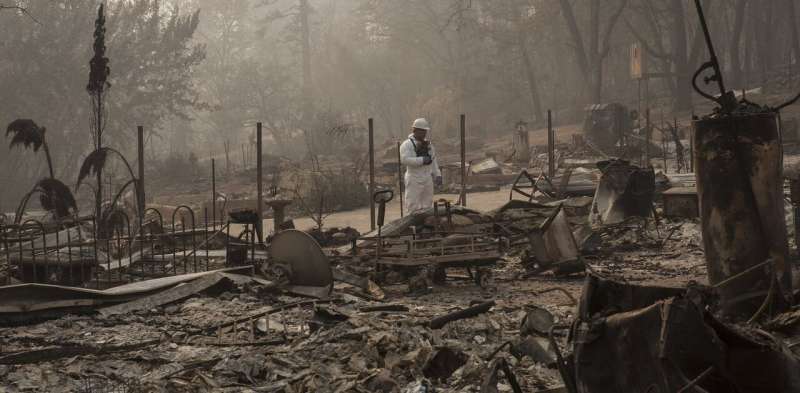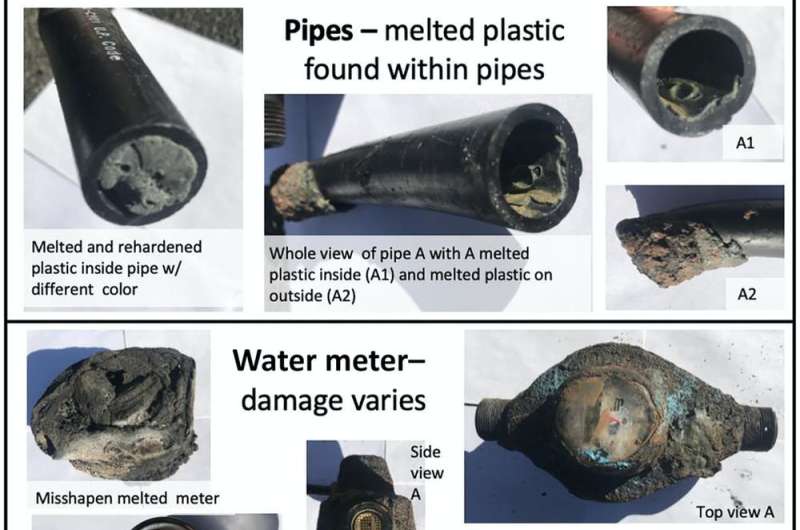Wildfires can leave toxic drinking water behind – here's how to protect the public

Less than halfway through the 2020 , fires are burning large swaths of the western U.S. As in previous years, these disasters have entered populated areas, damaging drinking water networks. Water systems have , potentially sucking in pollutants, and several utilities are warning of and .
We are who help communities affected by disasters, including support for responses to the 2017 Tubbs Fire and 2018 Camp Fire in California. As we concluded in a recently published , communities need to upgrade building codes to keep wildfires from causing widespread contamination of drinking water systems. They also need to act more aggressively to protect residents from possible toxic exposure immediately after fires.
How wildfires poison water systems
After both the 2017 in and the 2018 in , drinking water tests revealed a plethora of acutely toxic and carcinogenic pollutants. Water inside homes was not safe to use—or even to treat.
Water pipes buried underground and inside of buildings were extensively contaminated. Both fires destroyed fire hydrants, water pipes and meter boxes. Leaks and ruptured hydrants were common.
After the fires passed, testing ultimately revealed widespread hazardous drinking water contamination in areas affected by both fires. Evidence suggests that the toxic chemicals originated from a combination of .
Chemicals in the air may have also been sucked into hydrants as water pipes lost pressure. Some water system plastics decomposed and leached chemicals directly into water. Toxic chemicals then spread throughout pipe networks and into buildings.
Limited water testing by state and local agencies showed that and were present at levels that could cause immediate physical harm. These chemicals, as well as , , and , .
All of these substances are – chemicals that readily evaporate into the air at room temperature. Many of them cause cancer. All can cause vomiting, diarrhea and nausea after a brief high-concentration exposure.
Simply running a cold water faucet can release volatile organic compounds from tap water into the air. Heating water for showers or cooking makes them enter the air even faster, creating a more severe inhalation risk. Some can also be absorbed through the skin.

Protecting the public
In our view, agencies should not underestimate health hazards posed by fire-damaged drinking water systems. Just in the past month, after the CZU Lightning Complex Fire burned parts of San Mateo and Santa Cruz counties, California officials and a water utility and an advisory allowing children to bathe in potentially contaminated drinking water. Five days later, when limited test results became available, both organizations recanted and said in the water.
To avoid this kind of error, we recommend issuing "Do Not Use" orders in the wake of major fires to protect the public before water testing results are available. We believe it is acceptable to use water for fire fighting and toilet flushing, but not for purposes that involve ingestion, skin exposure or inhalation, such as bathing or cooking.
Under no circumstance should people be told to to determine its safety, as officials recommended for months after the Camp Fire. Many harmful chemicals have no odor, so only testing can determine safety.
Advisories to boil water should not be used, since boiling speeds up the release of toxic chemicals into the air. Nor do we recommend "Do Not Drink/Do Not Boil" advisories, which allow bathing in contaminated water.
Before agencies lift or modify advisories, we believe they should be required to carry out thorough chemical screens of water systems. Too often, officials charged with protecting public health , . More typically, they act like California's San Lorenzo Valley Water District, which lifted a post-wildfire "Do Not Drink/Do Not Boil" order in parts of its territory on Sept. 7, 2020 with a notice to ratepayers that ."
Agencies also need to test buildings for water contamination. Home drinking water quality can , so reliable testing should sample both cold and hot water at many locations within each building.
While infrastructure is being repaired, survivors need a safe water supply. Water treatment devices sold for home use, such as refrigerator and faucet water filters, are not approved for extremely contaminated water, although sales representatives and government officials may the devices can be used for that purpose. While survivors wait for safe water to return, government agencies should ensure that reliable emergency water supplies are available.
Update building codes for future fires
Our research underscores that community building codes are inadequate to prevent wildfire-caused pollution of drinking water and homes.
Adopting codes that require builders to install fire-resistant meter boxes and place them farther from vegetation would help prevent infrastructure from burning so readily in wildfires. Concrete meter boxes and water meters with minimal plastic components would be less likely to ignite. Some plastics may be practically impossible to make safe again, since all types are susceptible to fire and heat.
Installing one-way valves, called , at each water meter can prevent contamination rushing out of the damaged building from flowing into the larger buried pipe network. Water main shutoff valves and water sampling taps should exist at every water meter box. Sample taps can help responders quickly determine water safety.
As the past several years have shown, many communities need to be better prepared for wildfires. Two years after the Camp Fire, the town of Paradise, California is , at an estimated cost of . We believe the time to upgrade in other towns is now.
Provided by The Conversation
This article is republished from under a Creative Commons license. Read the .![]()


















